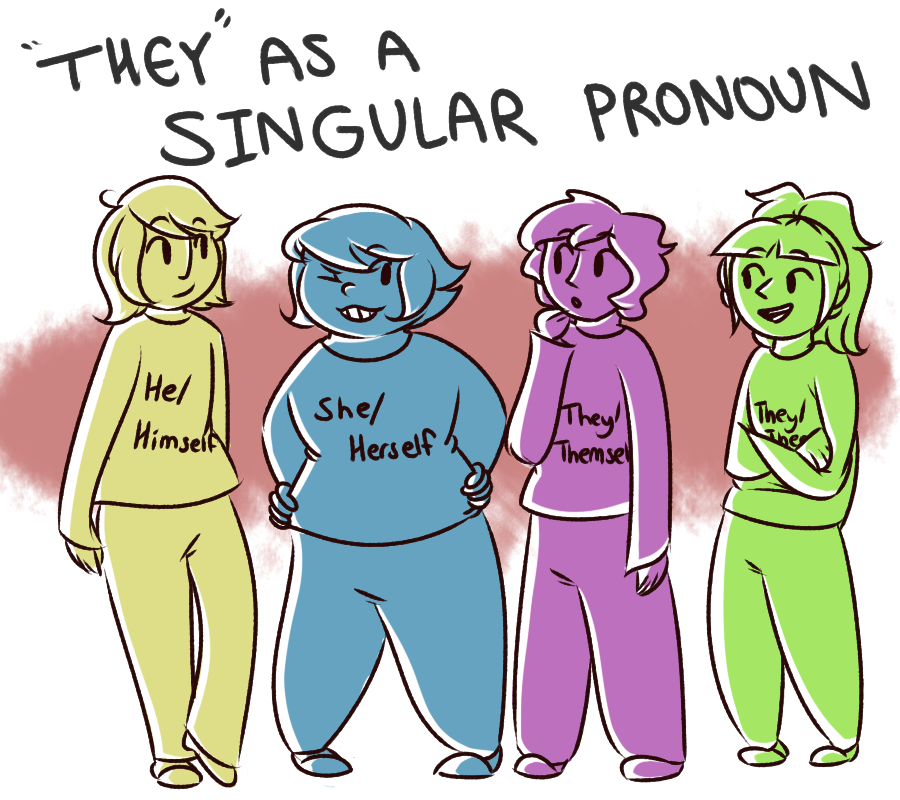The Singular They-Them
November 25, 2015
They walk to the market. Their clothes are bright and vivid. The teacher greeted them with a smile. Ordinarily, these pronouns are reserved for plural terms or groups of people; however, more and more organizations such as the APA (American Psychological Association) and the Wall Street Journal, as well as dictionaries like Oxford and Merriam Webster, are recognizing the usage of the singular they/them.
“But aren’t there only two genders?” you may inquire. To that notion, I would respectfully disagree. Gender, by definition, is a social construct. It encapsulates the range of characteristics between masculinity and femininity, including societal structures and tasks given to certain sexes. Instead of being a binary of male and female, gender is a spectrum, just as significant and impressionable as other facets of personality.
(Side note: As a cisgender girl, I cannot speak as if I have personal experience on non-binary genders, but I will try my best to inform)
“Isn’t this ‘third gender’ concept fairly recent? How can numerous genders exist if this phenomenon just came into creation?” you stubbornly claim. In reply, I cite the ancient civilization of Egypt. Pottery shards from the Middle Kingdom of Egypt (2000-1800 BC) listed three human genders – tai (male), hmt (female), and sḫt (pronounced ‘sekhet’). Olden religions, such as Buddhism and Hinduism, also recognize a gender that is neither male nor female.
“Alright, so maybe there are more than just men and women.” you may confess. “But why would someone identify as neither?” Simply put, they do so for the same reasons many people see themselves as male or female. Non-binary refers to genders outside of the male-female binary (neither male nor female), while genderqueer refers to genders separate from the conventional gender distinctions (non-normative). Non-binary people come in all kinds of shapes and sizes; you don’t have to look androgynous (gender-neutral) to be neither male nor female. Someone with facial hair can be non-binary, as well as someone with visible curves.
In the proverbial rainbow of gender, let’s say that male is blue and female is red. A non-binary person can be purple (both masculine and feminine), yellow (neither masculine nor feminine), or any color in between. Therefore, instead of using ‘he or she’ for the singular, you can respect those who identify elsewhere and use the ‘they’ singular. Examples include, “Hey, who was that person sitting next to me? What’s their name?” and “Every student must bring their own pencil and paper.”
If people wish to be referred to using they/them pronouns, respect their desires. Since gender is not a binary, use they instead of ‘he or she’. Brush away the habit of assuming people’s genders and simply ask, “Hey, what are your preferred pronouns?”. Overall, keep an open mind. Thanks for reading, to all my guys, gals, and non-binary pals.
More information:
http://www.wsj.com/articles/can-they-be-accepted-as-a-singular-pronoun-1428686651
http://blog.apastyle.org/apastyle/2015/11/the-use-of-singular-they-in-apa-style.html
http://blog.oxforddictionaries.com/2012/06/he-or-she-versus-they/
http://www.merriam-webster.com/dictionary/they
https://motivatedgrammar.wordpress.com/2009/09/10/singular-they-and-the-many-reasons-why-its-correct/
http://nonbinary.org/wiki/Pronouns







